Your Donations at Work
- Ornithology: Barn Owl Surveys Complete!
- Herpetology: Biologists Monitor Mudpuppies, and You Can Help
- Mammalogy: A Rare Sighting of the Least Weasel
- Aquatics: Surveys Reveal One of Indiana's Rare Fish Species at Twin Swamps
- Put Your Tax Return to Good Use: Support Rare and Endangered Wildlife
- Upcoming Events!
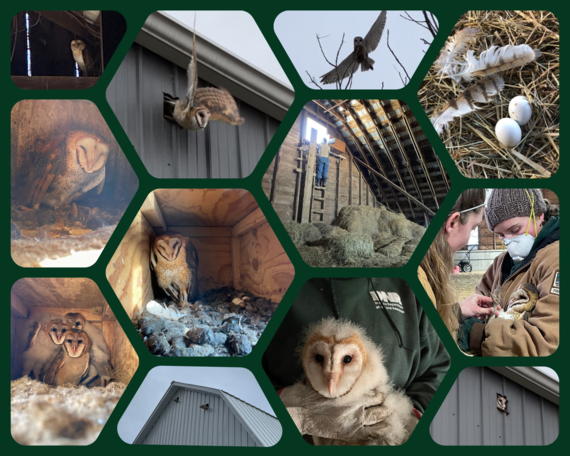
Barn Owl Surveys Complete!
You walk through a prairie late at night and hear a chilling screech fill the air. As your heart races, you wonder, 'what in the world was that?' A blur of wings flies by above you—the elusive barn owl, with its white, heart-shaped face and broad wings, just seems to be wishing you goodnight.
The barn owl has been an endangered species in Indiana since the early 1980s due to the loss of grassland habitats, the places where the owls hunt and breed. Although they are endangered, populations have steadily increased in recent years due to DNR and landowner efforts to provide barn owl nest boxes. The Indiana DNR installs nest boxes inside barns with the box entrances facing toward grasslands and other suitable hunting spaces like pastures and fallow fields. These boxes provide a safe place for barn owls to raise their young during their breeding season from March to late summer. In one nesting attempt, a barn owl can lay between three to 11 eggs, with one egg laid each day! Often, there is not enough food for the entire brood and only the oldest chicks survive.
Ornithologists (i.e., bird biologists) at the Indiana DNR determine if barn owls are present by looking at the evidence the owls left behind such as feathers, whitewash, and pellets. Because barn owls swallow their prey whole, they regurgitate the undigested remains of small rodents, like voles and mice, in the form of pellets containing fur and bones. These dark, oval pellets are about 4-5 inches in length, and each pellet contains the remains of one rodent. The regurgitated pellets don’t go to waste—the owls use them as nesting material, and ornithologists use their mass to estimate the year the barn owl inhabited the nest box.
Many people use rodenticides (poisons that kill small mammals) to control small mammal populations around them; however, barn owls can be poisoned by consuming rodenticide-laden prey. To help barn owls thrive, find alternative means of control, such as cleaning up food waste that may attract rodents. Providing a nest box and placing it in open country is another great way to encourage the barn owl population’s success in Indiana.
Every four to five years, DNR surveys nest boxes statewide. In the winter of 2022-23, 311 nest boxes were checked, and 79 were found hosting a barn owl nest that was active in 2022. During the previous survey in 2017, only 43 boxes hosted nests from that year. This sudden rise in the number of nests is partially due to the efforts of DNR and private landowners providing nest boxes in large open grasslands of 100 acres or more.
As you amble along paths at night and hear the barn owl’s cry, remember that although it may sound scary, a silent night without its cries would be even scarier. To support DNR’s work with barn owls, donate to the Nongame Wildlife Fund.
|
Figure 1: Number of barn owl nests found during 2022 statewide barn owl nest box survey
|
|
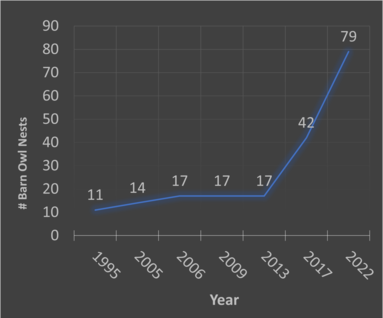 |
Biologists Monitor Mudpuppies, and You Can Help
DNR biologists are tracking records of the mudpuppy, a Species of Special Concern in Indiana. Mudpuppies are one of Indiana’s largest salamanders, reaching more than 12 inches in total body length. Mudpuppies occur statewide, but the conservation status of the species has been difficult to assess because of their secretive habits. Mudpuppies are fully aquatic and spend their entire lives in lakes, rivers, and streams. They are sometimes caught by anglers but may also be observed crawling along lake bottoms at night, especially during winter and early spring. Mudpuppies are often gray to brown in color with dark spots and can be identified by their fluffy, reddish external gills behind their head.
Have you seen a mudpuppy? Observations can be reported to the DNR herpetologist at HerpSurveys@dnr.IN.gov. Be sure to include a photo and information about the date and location of your find. Public reports of mudpuppies help DNR biologists understand the status and distribution of this interesting Indiana salamander.
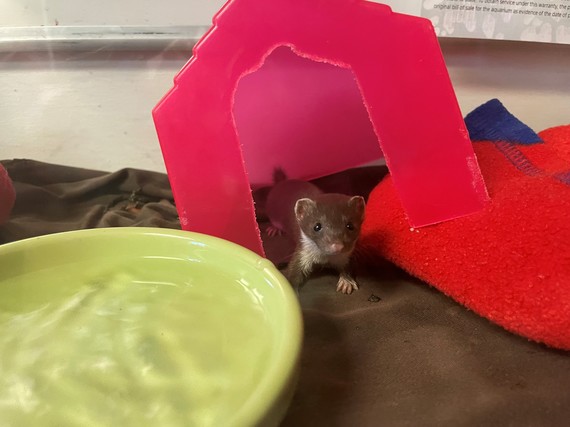 A Rare Sighting of the Least Weasel
The smallest carnivore on earth, the least weasel grows to 6-8 inches in length and weighs an average of 55 grams (the same weight as a slice of bread or two AA batteries). Least weasels are found primarily in Europe and North America, including right here in Indiana, where they are listed as a Species of Special Concern due to their limited distribution and the difficulty of assessing their population. This tiny predator uses a wide variety of habitats, such as prairies, forests, shrublands, and wetlands, and even lives near humans. In fact, earlier this year, the least weasel shown above was found by homeowners after it had fallen into their basement window well. The starving weasel was rescued by the homeowner, who took it to a wildlife rehabilitator for a short stay (and lots of mice snacks). The weasel was later released back on the homeowner’s property after she had reached a healthy weight.
Although small, least weasels are voracious hunters of mice, voles, gophers, and other vertebrates, which are usually much larger than the weasel. These hunters are active year-round, and they tend to form their dens in logs, rock crevices, or even in the burrows of their prey. Their coats stay brown on top with a white belly in the summer, and turn white except for their black tail tips in the winter. Least weasels play an important role in the ecosystem but unfortunately are threatened by human harassment or poisons that target rodents. Choosing preventive methods of pest control (such as cleaning up garbage or fallen fruit that may attract pests) can help preserve the least weasel population.
Least weasels can be identified by their small size and differentiated from similar species, such as the long-tailed weasel, by their stubby tail. Help the DNR monitor the least weasel population by reporting any observations of this species.
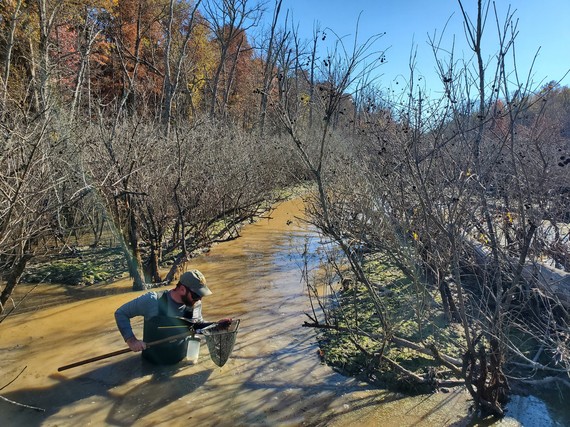 Surveys Reveal One of Indiana's Rare Fish Species at Twin Swamps
The banded pygmy sunfish is the northernmost species and only species of the family Elassomatidae found in Indiana. It is also one of the 11 fish species on Indiana’s list of Species of Greatest Conservation Need. Because this tiny fish does not exceed 2 inches in length and prefers to hide in thick aquatic vegetation found in sloughs, oxbows, swamps, and ditches, it can be tricky for biologists to sample. Despite these less-than-ideal conditions, Indiana DNR staff have been conducting surveys for these fish since their discovery in Knox County in 2006, with hopes of determining the species’ status and distribution in the state. In 2022, two new habitats for the banded pygmy sunfish were discovered: Cypress Swamp and Overcup Oak Swamp in Twin Swamps Nature Preserve, both in Posey County.
DNR hopes that with continued diligent surveying, we will better understand how prevalent the banded pygmy sunfish is in Indiana waters in the coming years. If you catch a fish you can’t ID, send a photo to fishid@dnr.IN.gov. You may have hooked the banded pygmy sunfish or another elusive species we are tracking.
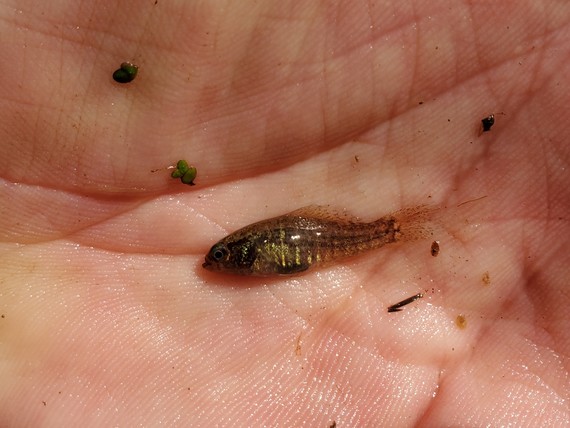
Put Your Tax Return to Good Use: Support Rare and Endangered Wildlife
Give your tax return a new lease on life - donate it to the Indiana Nongame Wildlife Fund! This fund supports Indiana's Species of Greatest Conservation Need, which are vital to our ecosystem and improve our quality of life. Think bats, birds, mussels, frogs, and all the beautiful and interesting critters featured in this newsletter. These animals need our help to survive and thrive, and your donation can make a big difference! For every $50 donated, an additional $93 in federal funds goes toward rare and endangered wildlife conservation.
To donate on your Indiana state taxes:
If filing with paper forms, use Schedule 5/Schedule IN-Donate. This video outlines the steps for filling out the form. If donating through online tax programs, you will be prompted to donate at the end of filing. If filing using a tax preparer, direct your preparer to the Schedule 5/IN-Donate (also referred to as IN Schedule 5-Credits).
To donate directly, either online or via mail, please click below.
Recent News Releases
|